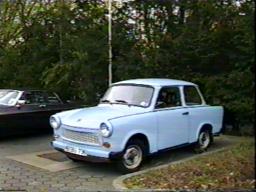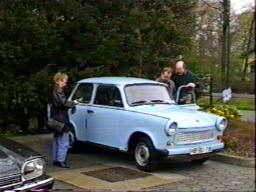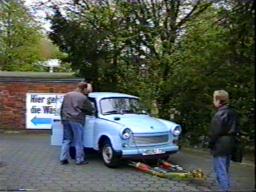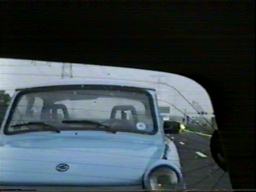
The Trabbie Trail
The story of our Trabant P601S
I casually mentioned to Ingo one day that I would quite like to buy a Trabbie to bring to England and use for a while; I can see the look on his face even now but he has gradually become accustomed to my eccentricities. Many years and frequent visits to each others’ places passed, when I got a call from him saying that a garage in Bremen had a blue one for sale for 1000Dm (around £350 back then). Although he is not a car buff, I asked him to go and see it and if he thought it worth the money, then to buy it. At first he thought it was a wind – up, as I am given to that sort of thing, but when he realised that I was serious, he went to see it properly and bought it on my behalf. He even managed to wangle keeping the German number plates for it, although the authorities had to remove the TUV (MOT) discs to invalidate them.

This was our first sight of it!
As it happened, Christine and I were booked on a trip to Holland with the Jag club only a month or so later, so I negotiated a return ticket for the Trabbie and loaded the one-man ‘A’ frame towing rig and lighting board into the boot of the XJS and off we went. We had a couple of days with the other club members in a lovely Hotel in Vught in Holland and then set off after an early breakfast to drive to Bremen for lunch with our friends. I paid Ingo his money and they gave us a special model Trabbie as a memento. It was then off at last to see my new acquisition. Ingo started it first time and drove it, with a huge grin on his face, around to the back of my car for me to fit the ‘A’ frame and half an hour later we were on our way! (Picture) Ingo led for a while until I let it all settle down and then he pulled into a Rastplatz on the Autobahn for a farewell chat. It certainly caused quite a stir wherever we went. Our crowd at the hotel were also taken aback, when they saw it the following morning as we were loading up to leave for the Ferry. We had a very pleasant trip away from the high speed Autobahns, the whole rig behaving itself perfectly all of the way to Calais for our return crossing. It travelled at some previously unrecorded speeds and without a hint of smoke, probably appearing to onlookers as if it was giving this old Jag a run for its money.


We all have a good look round Connected to the A frame

That Trabbie sure looks close!
I had a few modifications to do prior to unleashing it on the MOT man but it passed first time and then it was off to the VRO in Preston to get the necessary paperwork done, before being granted an age-related number for it, to replace the German one. I spent some time tidying up one or two little bits and pieces and painted the rear bumper in Gletscher Blau (glacier blue), which my local paint stockists found the formula for! I also repainted the rear lamp bases which are made from bakelite and consequently difficult, unless they are well keyed. The headlamp rims were slightly scruffy so I did those too, but with no problem, as they are metal. We were invited to exhibit the car at the Meols Hall show (Southport) that year, where it once again bore its German plates and I am amazed at how many people wanted to get a close up view and photo of it; three rather elderly ladies even expressed a wish to take turns at sitting in it! I think it probably created more interest than anything I have ever taken to any show, including the Jag! When I visited a classic car show in Essen in the north of Germany in ‘97(no, not in the Trabbie!!) I watched some rare video footage of the assembly line at the factory, and discovered that the reason for the very uniform panel gaps, was that they fit the panels butted up to each other and then go down with a rotating disc cutter and chop out a parallel gap!
Around town and for commuting it really is a wonderful little car and being a two stroke, is surprisingly quick off the mark; frequently catching the odd BMW in the outside lane at the traffic lights, completely unawares (up to about 20mph anyway!) All of the talk of smoke screens is also nonsense if you are strict with the mixing ratio for oil/fuel, it’s only a problem if you are in the habit of chucking in a bit extra ‘just in case’. It does require a certain amount of discipline when driving in the wet, on the cross ply tyres – it’s easy to forget how things have changed over the years and it certainly makes you appreciate what the everyday transport in Eastern Europe was like. Our car came originally from Berlin in 1989, so was one of the last to be made and the lady who got it new had to wait a number of years before she was allowed to have one! Can you imagine ordering a car and waiting for almost TEN years, only to end up with a Trabant? The very last ones to be made had a VW Polo catalysed engine and a proper petrol tank and even chrome bumpers and headlamp rims!
I used the Trabbie on a daily basis for a full year and was quite impressed at its usefulness. I still occasionally went to the wrong side to get in, especially when leaving work and you couldn’t even pretend you had done it deliberately, as there was no external lock on the passenger door! A good friend of mine (still is too!) frequently expressed a wish to have the car if I ever wanted to part with it, so I recently passed it on to him on the understanding that he would let me buy it back if he no longer needed it.